Three points was all that separated Eintracht Frankfurt and TSG 1899 Hoffenheim last season, with Frankfurt finishing on 54 points and in seventh place, Hoffenheim just behind in ninth place.
Frankfurt won both games against Hoffenheim last season, 2-1 and 3-2, respectively. However, with Hoffenheim scoring in every away game in the Bundesliga last season, and Frankfurt’s attack being severely weakened after the sale of the prolific Luka Jović and Sebastian Haller, Hoffenheim would have been confident going into the game at the Commerzbank-Arena.
This tactical analysis will look at how Frankfurt managed to prevent Hoffenheim from capitalising on their possession and keep a clean sheet as they won 1-0.
Lineups
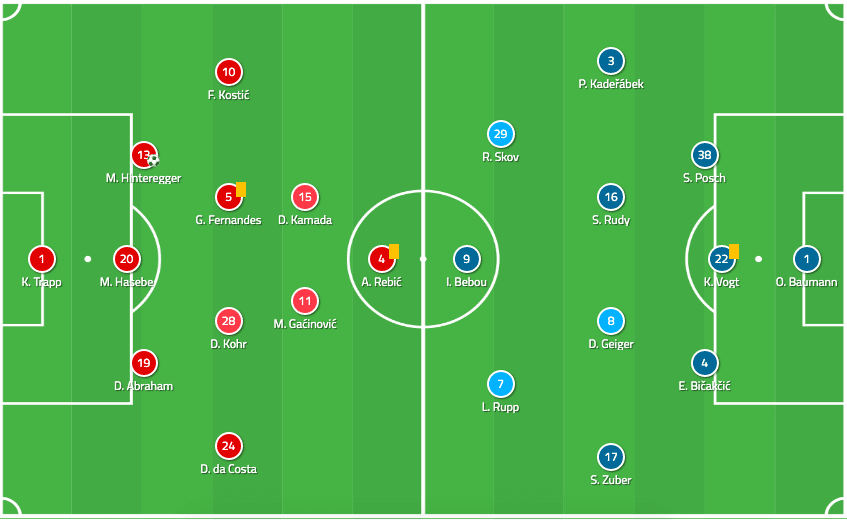
Both sides lined up with near-identical formations, with the 3-4-3 being utilised in some form. The only difference was that Frankfurt manager Adi Hütter, opted to drop both Daichi Kamada and Mijat Gaćinović, behind Ante Rebić. Hoffenheim Head Coach Alfred Schreuder used Lukas Rupp, alongside new signings Robert Skov and Ihlas Bebou as a front three.
It was a huge opportunity for Kamada to impress, with the impending signing of Bas Dost meaning Rebić will likely revert to the left.
How the early goal affected the game
Set pieces were a theme throughout the game for Frankfurt. They obviously thought that Hoffenheim were susceptible to an aerial threat. It took only 34 seconds for Frankfurt centre-back Martin Hinteregger to find himself free in the 18-yard-box. Hoffenheim right-wing-back Pavel Kadeřábek was given the task of marking him, and his body position, with his back to the ball meant Hinteregger was able to read the delivery and hammer home the cross with his left boot. In the below analysis we can see Kadeřábek is looking at Hinteregger as the ball is delivered.
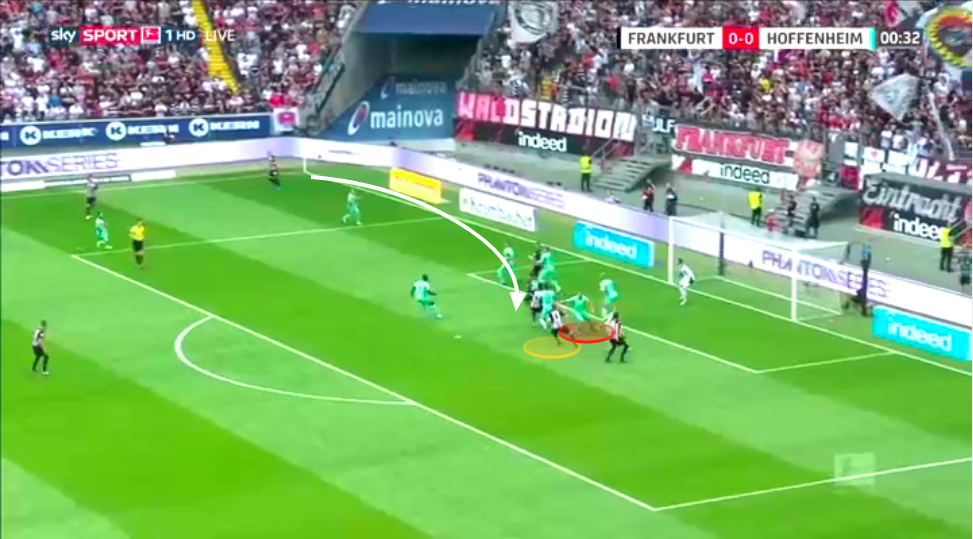
Frankfurt immediately went on the attack again after the goal, and it looked like it could be a long afternoon for Hoffenheim. Yet this pressure lasted for only the first ten minutes.
Hoffenheim began to get a grip of the game, and it appeared Frankfurt were happy to sit deep and prevent Hoffenheim from breaking them down, whilst looking to hit them on the counter.
The score would remain 1-0 for the rest of the game, and despite Hoffenheim enjoying the majority of the ball with 64.44% possession, it was Frankfurt that enjoyed the better chances. This was down to their defensive tactics, and how quickly they countered.
Frankfurt’s defensive shape and Hoffenheim’s build-up play
Both teams looked to play out from the back. When Hoffenheim keeper, Oliver Baumann, had the ball at his feet, he would initially look to play forward. Yet Frankfurt were determined to make Hoffenheim play wide, and not let them get the ball into centre-midfielder Dennis Geiger.
When the wider two centre-backs, Stefan Posch and Ermin Bičakčić, split wide, central centre-back Kevin Vogt would push higher and look to receive between the defensive and midfield lines.
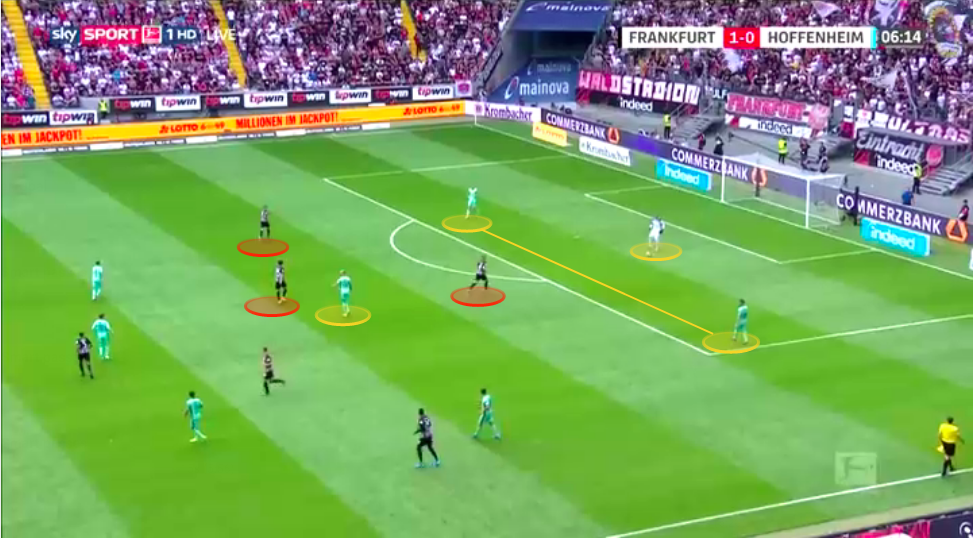
Above we can see that Baumann is in possession and the two wider centre-backs of the back three have split wide, as Vogt looks to receive the ball higher up.
Frankfurt counter-acted this by positioning their front three, very narrow, and stopping the ball from being played forward. In this case, where Vogt is higher, it allows Rebić to press the goalkeeper.
Yet throughout the game, this was the only situation where Hoffenheim were consistently pressed by Frankfurt in their own half. Hütter was aware that Hoffenheim wanted to break the defensive line with one pass, and usually, the intended recipient was Geiger. When Geiger dropped deep to receive we see a similar set up by Frankfurt.
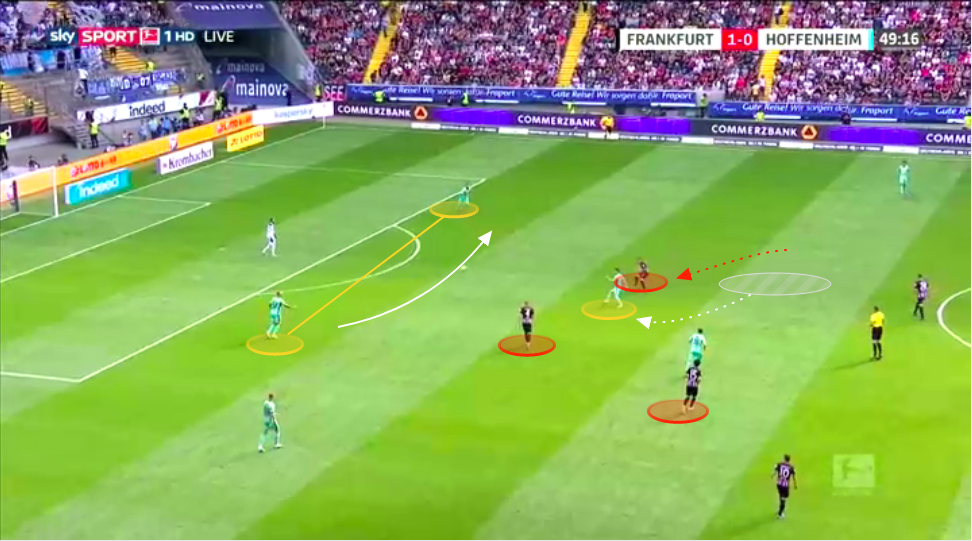
When it was Vogt, and not Baumann, that had the ball deep, it gave Geiger space to move into to receive the ball. Frankfurt were wise to this and sat a little deeper, but still made sure to prevent Geiger from receiving, and forced Hoffenheim wide.
Frankfurt would otherwise keep their shape and allow Hoffenheim to advance to the halfway line, maintaining their 3-4-2-1 shape. It was at this point though, where Frankfurt’s defensive shape was particularly effective in stopping Hoffenheim from playing centrally.
The wing-backs fell back to create a back five, and this created a 5-2-2-1. Frankfurt sat very deep, and very narrow, to prevent the ball from being played into the front three. Rebić would remain high, marked by a sole centre-back, and for much of the game, a 9v9 was fought out in the Frankfurt half.
Below we can see how narrow the midfield is, shutting off the option to play centrally for Hoffenheim.
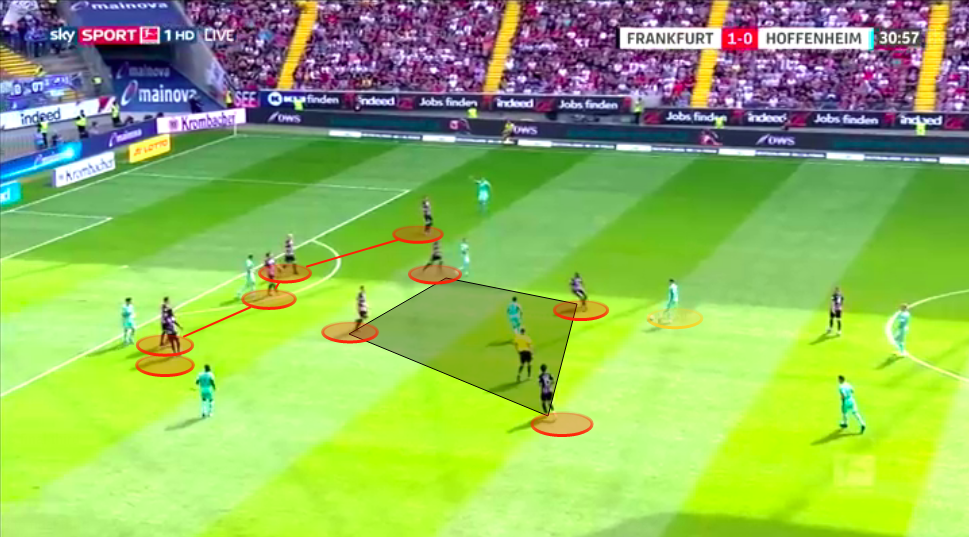
The Hoffenheim front three looked to position themselves close together, inside the defensive back three. The aim of this was the have quick interchanges with Bebou used as a target man to lay the ball off for either of the wide-forwards. Rupp and Skov stayed close to pick up on any loose balls near the target man. Forcing them wide annulled much of the threat posed by Skov, Bebou and Rupp.
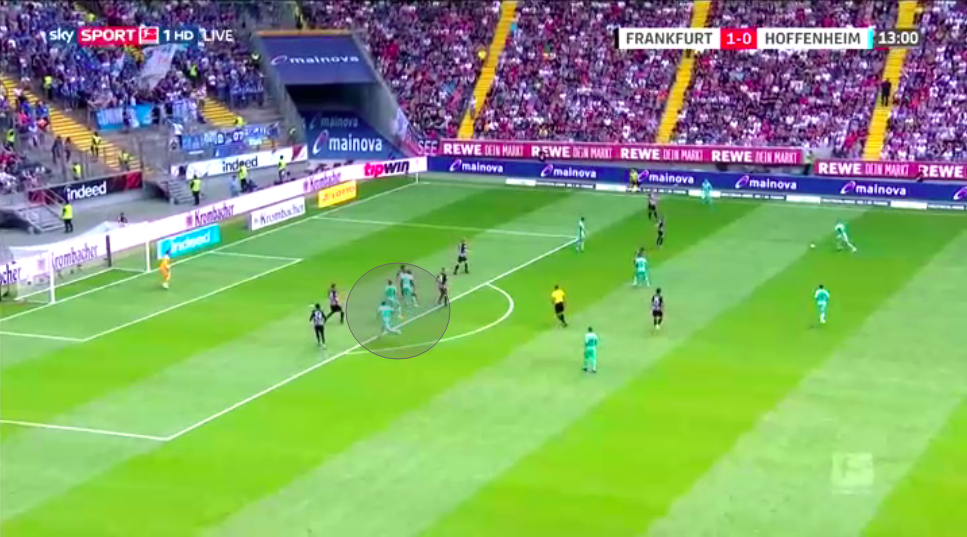
Once the ball was worked wide by Hoffenheim, Frankfurt would revert to a more conventional 5-4-1.
Frankfurt’s defensive shape was very effective in keeping them at bay, and despite all of their possession, Hoffenheim managed only one effort on target from eight attempts. Skov’s tame free-kick was the only save Kevin Trapp had to make.
Hoffenheim did score though, Geiger’s strike from outside the box flying past Kevin Trapp. VAR ruled out the goal due to Rupp obstructing Trapp’s view in an offside position.
Frankfurt were far more potent offensively, registering eight shots on target, out of 15 efforts. This was predominantly down to how Hütter set up Frankfurt’s counter-attacking.
Frankfurt’s counter-attack
Filip Kostić was used as left-wing-back by Hütter. It was the winger’s excellent dribbling performance and pace on the break that caused so many problems for Hoffenheim. Kostić completed 63% of his dribbles, creating two shots on goal, making two crosses, and winning two free-kicks in the final third.
We can see in the image below just how frequently his left flank was used in launching Frankfurt’s attacks.
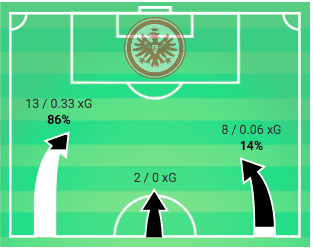
His speed and skill in the 1v1 situation helped Frankfurt to turn defence into attack in a matter of moments. This alleviated the sustained pressure their defence had withheld from Hoffenheim. The long ball was played frequently to do just this, with 20.5% of Frankfurt’s passes being comprised of long balls.
Frankfurt were allowed to get forward by Hoffenheim, whereas Frankfurt used rotational fouling to prevent Hoffenheim from doing anything similar. Frankfurt’s 19 fouls compared to Hoffenheim’s nine backs this up.
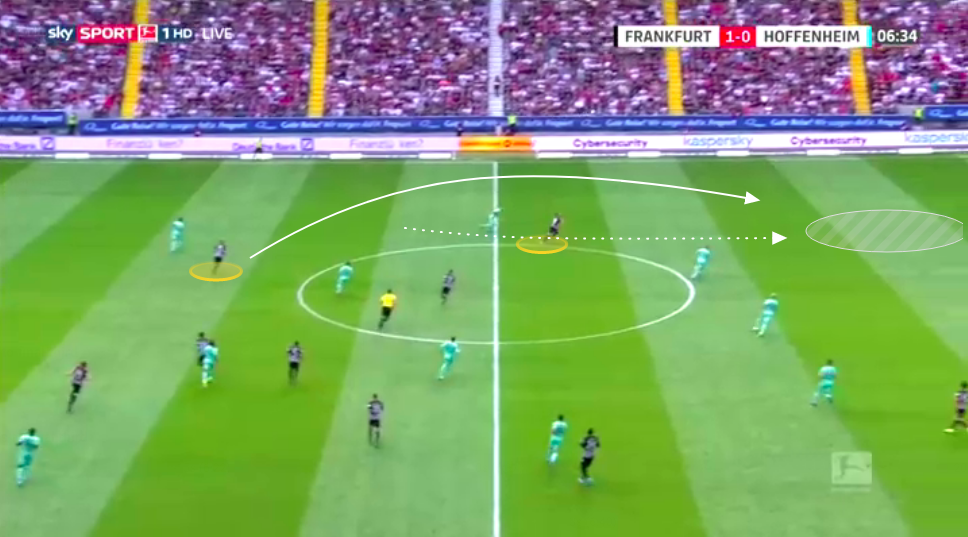
Both Kostić and right wing-back Danny Da Costa were expected to get forward quickly and be the wide outlet.
It proved to be the most effective way for Frankfurt to launch attacks. Hoffenheim did an excellent job of preventing them from playing the ball into the front three, particularly Rebić. Only 63.37% of their forward passes were accurate.
Conclusion
Frankfurt’s fast start, along with Hoffenheim’s goalscoring record away from home, suggested this could be a high-scoring game. Yet what unravelled was a game of cat and mouse. Hoffenheim probed and prodded Frankfurt’s defence, unsuccessfully looking for an opening. Frankfurt soaked up the pressure and broke quickly on the counter.
There were positives to take from the game for Hoffenheim. They kept the ball for long periods of time and played adventurous passing football starting from their back three. Despite their abysmal finishing, they were nevertheless unlucky not to take something from the game.
Frankfurt, on the other hand, will be pleased to come away with three points despite little possession. Yet they created enough chances to win by more than one goal. Hoffenheim’s expansive style of football allowed them to use the pace of their wingback’s and Rebić to stretch their opponent on the counter-attack. Against poorer teams who will happily play Frankfurt at their own game, this could be a problem. Without the goalscoring exploits of Jović and Haller this season, another forward needs to step up.
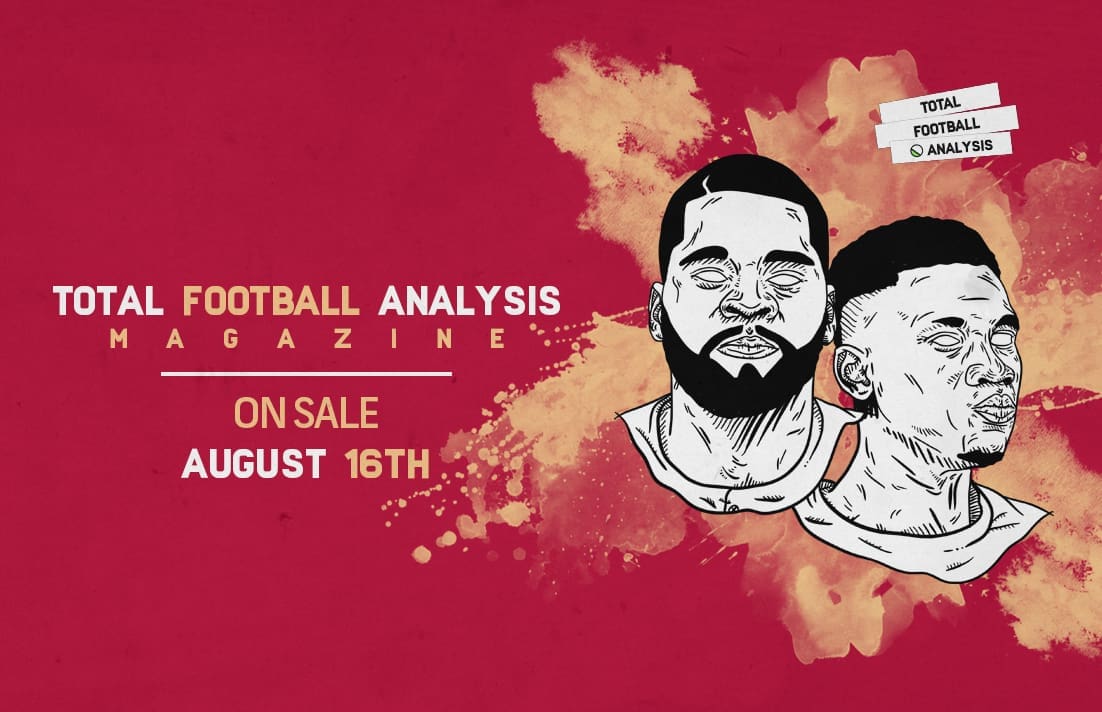
If you love tactical analysis, then you’ll love the digital magazines from totalfootballanalysis.com – a guaranteed 100+ pages of pure tactical analysis covering topics from the Premier League, Serie A, La Liga, Bundesliga and many, many more. Buy your copy of the August issue for just ₤4.99 here.

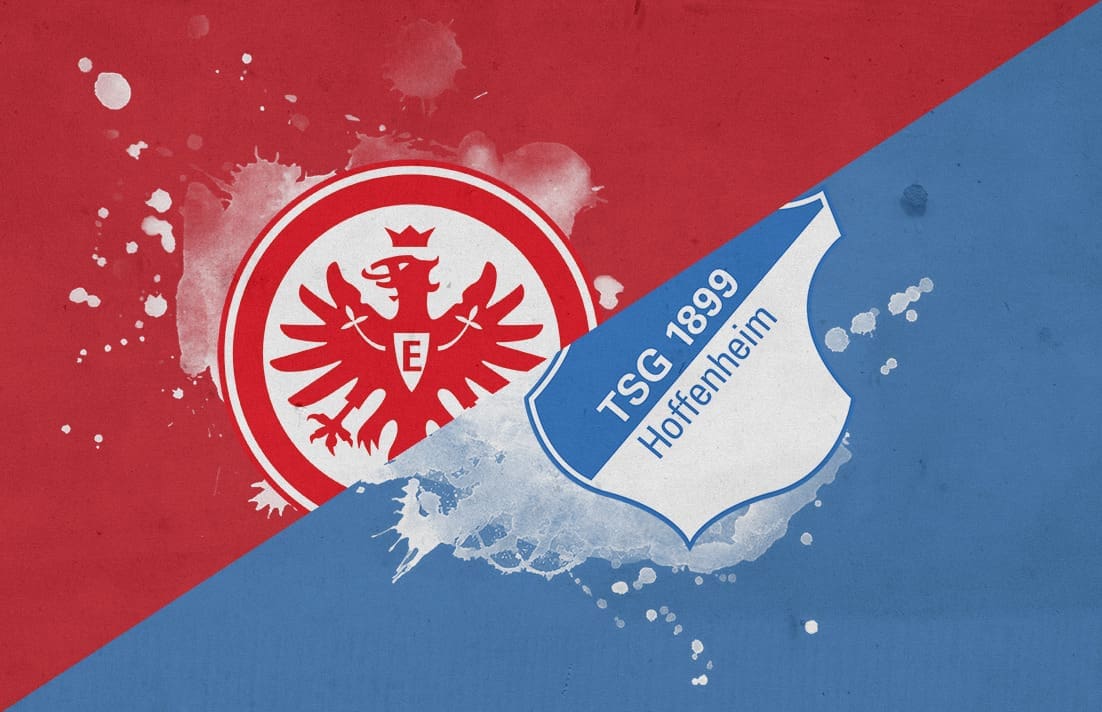



Comments